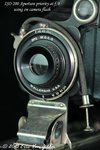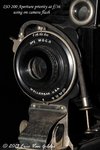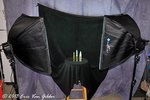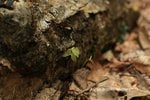my solution is to make as many photo's as possible. We had quite some overcast in Oostwold. I took around 800 pics, some odd 600 of which were totally blurred, the rest consisted of either half an aircraft, no aircraft at all or duplicates, leaving around 60 very good pictures. That's less than 10%.Good point, Marcel and I'll set my aperature and shutter manually in many cases.
On that particular day, the varying overcast was causing me to get blurry shots of the aircraft if the shutter speed was any lower. I blew several shots until finally letting the shutter go auto by setting the f-stop and I was able to get sharper shots with a little prop blur.
Navigation
Install the app
How to install the app on iOS
Follow along with the video below to see how to install our site as a web app on your home screen.
Note: This feature may not be available in some browsers.
More options
You are using an out of date browser. It may not display this or other websites correctly.
You should upgrade or use an alternative browser.
You should upgrade or use an alternative browser.
Photography - equipment, help hints
- Thread starter GrauGeist
- Start date
Ad: This forum contains affiliate links to products on Amazon and eBay. More information in Terms and rules
More options
Who Replied?Glider
Major
I'm looking at buying a DSLR Camera and I've narrowed it down to between a Nikon and a Sony. Has anybody every used the Sony SLT-A57?
I own an earlier Sony the A700 but my son has the Sony SLT-A55 and he is delighted with it. The video is good enough for him to use for coaching Archery and the quality he gets is first class. A number of his shots have been used in Archery publications.
evangilder
"Shooter"
I prefer quality over quantity when taking shots. I have stood next to guys that press and hold the shutter while it takes 20-30 shots on a single pass. UGH! Pick your shot and make it count! For airplanes, I shoot shutter priority and will adjust as necessary and as comfort allows. Shutter speed depends on focal length and whether or not your lens has any image stabilization. My 50-500mm does not have any image stabilization, and I never use a tripod or monopod when shooting airplanes. So I have to be steady. I will usually start the day with faster shutter speeds and slow it down as I get settled in. The general rule of thumb is 1/focal length for max shutter speed. But I have never been one to use the rules.  I highly discourage anyone using full auto. Your results will vary and while you will get some nice photos, if you are photographing prop planes, you will stop the props altogether on sunny days.
I highly discourage anyone using full auto. Your results will vary and while you will get some nice photos, if you are photographing prop planes, you will stop the props altogether on sunny days.
FG-1 Corsair shot full auto in 2006, before I knew better:

At 1/500th (shot at 500mm) I get some prop blur, but not a lot.

But at least there is a sense of motion and everything else is in focus. While prop blur is a good thing, everything else blurry is not what anyone wants. Once comfortable with your gear and your techniques, experiment with lower shutter speeds. I think it is better to get your technique and composition skills at higher shutter speeds first. Otherwise you are just learning to take out of focus shots.
Now, with that being said, prop blur getting a full prop arc is the nirvana for some photographers. It all depends on the effect you want. Here are some examples:
Helicopter at 1/80th at 500mm. Tail rotor, full arc. Top rotor, good blur.

To contrast, here is the same helo, same show at 1/500th at 500mm. Some blur, not much, but shows motion. However, look at the jet wash from the exhaust. The level of detail in the exhaust is not evident at lower shutter speeds.

Keep in mind that full prop arc only works when the prop disc can be seen, like when light is dancing off the prop. Otherwise, it may look like there is NO prop. I have done that.
Here is an example of prop disappearance, at a higher shutter speed. The prop is just barely visible.

It all depends on conditions and lightning. Here is a Super Tucano with some nice blur.

Same airplane, different lighting (same day, time of day different)
Nice light, good arc

Light later in the day, less arc, and less visibility on the prop.

Lastly, situational awareness is KEY! Not only will it keep you alive if shooting airplanes on a moving ramp, it will also help you time shots at the right moment. My son has totally picked up on this.
Putting together prop arc and situational awareness...

FG-1 Corsair shot full auto in 2006, before I knew better:
At 1/500th (shot at 500mm) I get some prop blur, but not a lot.
But at least there is a sense of motion and everything else is in focus. While prop blur is a good thing, everything else blurry is not what anyone wants. Once comfortable with your gear and your techniques, experiment with lower shutter speeds. I think it is better to get your technique and composition skills at higher shutter speeds first. Otherwise you are just learning to take out of focus shots.
Now, with that being said, prop blur getting a full prop arc is the nirvana for some photographers. It all depends on the effect you want. Here are some examples:
Helicopter at 1/80th at 500mm. Tail rotor, full arc. Top rotor, good blur.
To contrast, here is the same helo, same show at 1/500th at 500mm. Some blur, not much, but shows motion. However, look at the jet wash from the exhaust. The level of detail in the exhaust is not evident at lower shutter speeds.
Keep in mind that full prop arc only works when the prop disc can be seen, like when light is dancing off the prop. Otherwise, it may look like there is NO prop. I have done that.
Here is an example of prop disappearance, at a higher shutter speed. The prop is just barely visible.
It all depends on conditions and lightning. Here is a Super Tucano with some nice blur.
Same airplane, different lighting (same day, time of day different)
Nice light, good arc
Light later in the day, less arc, and less visibility on the prop.
Lastly, situational awareness is KEY! Not only will it keep you alive if shooting airplanes on a moving ramp, it will also help you time shots at the right moment. My son has totally picked up on this.
Putting together prop arc and situational awareness...
Whow Eric, that last one is great.
evangilder
"Shooter"
Thanks, Marcel. I know that I have missed shots like that in the past, so it's a good example of what having your SA honed can make a difference between a memory and a shot.
vikingBerserker
Lieutenant General
Those are great pics gent!
It sure was a lot easier buying Kodak Brownies.
It sure was a lot easier buying Kodak Brownies.
Airframes
Benevolens Magister
Thanks very much for the input Dave, Marcel and Eric.
Looks like I'm on the right lines, and like Eric, I prefer to choose my shots, taking perhaps a burst of three, maybe four, but mainly individual, spaced shots.
I agree about the slower shutter speeds for prop aircraft, and normally use around 1/125th, depending on conditions, with somewhere between 1/250th to 1/500th for fast jet action.
So, I'll go mainly with AF-C, spot metering, with dynamic as needed, on shutter priority, and hope my crippled hands don't let me down!
I've rigged up a pistol grip and remote release, as I can't use a 'proper' pistol grip with integral trigger, due to the stiff fingers, and have to use the third finger tip of my right hand on the button!
This is still off-balance, so eventually I think I'll rig a flash extension bracket with the grip, offset slightly to the right of the camera body, to balance things out. But let's see what this first foray turns out like first!
Looks like I'm on the right lines, and like Eric, I prefer to choose my shots, taking perhaps a burst of three, maybe four, but mainly individual, spaced shots.
I agree about the slower shutter speeds for prop aircraft, and normally use around 1/125th, depending on conditions, with somewhere between 1/250th to 1/500th for fast jet action.
So, I'll go mainly with AF-C, spot metering, with dynamic as needed, on shutter priority, and hope my crippled hands don't let me down!
I've rigged up a pistol grip and remote release, as I can't use a 'proper' pistol grip with integral trigger, due to the stiff fingers, and have to use the third finger tip of my right hand on the button!
This is still off-balance, so eventually I think I'll rig a flash extension bracket with the grip, offset slightly to the right of the camera body, to balance things out. But let's see what this first foray turns out like first!
evangilder
"Shooter"
Yeah, definitely AF-C. Depending on conditions, I used weighted spot metering and sometimes spot metering. The only potential issue with just spot metering is if you catch a glare, your metering will darken everything down and your photo may look like a night shot. It also depends on how good your metering is. (The D80 gave me a lot of trouble with it). They do make a rifle stock type of grip for cameras too. I know some guys that have used them with good results. It just depends on how much gear you want to schlepp back and forth to the show line.
vikingBerserker
Lieutenant General
Well gents, I just bought the Pentax K-5 with a couple of lenses. I have 1.5 months to learn how to use this thing before my visit to the USAF Museum!
- Thread starter
- #270
GrauGeist
Generalfeldmarschall zur Luftschiff Abteilung
Congrats!
We'll be looking forward to see your photos
We'll be looking forward to see your photos
evangilder
"Shooter"
With a month and a half, you have a good amount of time to take lots of pictures to learn. Try different settings in shutter priority, aperture priority, changing ISO values, the works. The more you understand the settings and what they do, the better you will be able to achieve the results you want. The best part of digital is that it doesn't cost a thing to learn, unlike the film days. Have fun with it. 
Great tips guys!
ontos
Tech Sergeant
A lot of great tips hear, these cameras are really fun for me to play with, my biggest problem is panning even with stabilization, I have to watch my breathing or I shake  I try to think like I'm at the target range
I try to think like I'm at the target range 
evangilder
"Shooter"
The old BRAS does apply for both Merv.
Breathe
Relax
Aim
Squeeze
Practice by working with things that don't move as quickly, but do it predictably, like a vehicle or bicycle rolling down the street. I use the center bracket as my guide. Follow the object with the camera and when the shutter opens and closes, the bracket should be in the same place. If it is, you have most likely nailed it. If not, you aren't alone. But it does make nailing it sweet. The fun part with doing it with vehicles is you should have wheel and tires blur while the rest is in focus.
I have been playing around with some new lights and have a couple of shots that show the depth of field/aperture correlation. The higher the f/stop, the greater the depth of field. But along with that is less light let in by the lens. Both are neat shots, and are both usable yet different, depending on the style you prefer.
Breathe
Relax
Aim
Squeeze
Practice by working with things that don't move as quickly, but do it predictably, like a vehicle or bicycle rolling down the street. I use the center bracket as my guide. Follow the object with the camera and when the shutter opens and closes, the bracket should be in the same place. If it is, you have most likely nailed it. If not, you aren't alone. But it does make nailing it sweet. The fun part with doing it with vehicles is you should have wheel and tires blur while the rest is in focus.
I have been playing around with some new lights and have a couple of shots that show the depth of field/aperture correlation. The higher the f/stop, the greater the depth of field. But along with that is less light let in by the lens. Both are neat shots, and are both usable yet different, depending on the style you prefer.
Attachments
vikingBerserker
Lieutenant General
Wow, what a difference that can make. What kind of flash or lights do you use? I need to figure out which I need to get before the visit.
I also need to get a low light lens, currently leaning towards a Sigma 50mm f/1.4 EX DG HSM .
I also need to get a low light lens, currently leaning towards a Sigma 50mm f/1.4 EX DG HSM .
evangilder
"Shooter"
I am using (currently) 2 softboxes with 5 bulbs each. They are CF bulbs, so they take a couple of minutes to warm up to their proper brilliance.The 5 bulbs are 45w CF bulbs, so they are pretty bright. I also bought a couple of 85W CF bulbs. They are huge, and the equivalent of 300+ Watts! Here is the setup I used.
The f/1.4 will be good, but keep in mind that at f/1.4, you will have a narrow depth of field. But upping it some and adding flash should be good for that environment. The only thing I will caution on with the 50mm is that you have to remember that the sensor has a bit of a multiplier effect, so 50mm is closer to a 75mm lens. I realized that after buying a 50mm. If you have a camera store nearby, you may want to see if you can try one in the store. Just looking through the lens, you will see how far back you will have to get. If I could do it again, I would look into a 35mm or a 28mm just to give me some wiggle room.
The f/1.4 will be good, but keep in mind that at f/1.4, you will have a narrow depth of field. But upping it some and adding flash should be good for that environment. The only thing I will caution on with the 50mm is that you have to remember that the sensor has a bit of a multiplier effect, so 50mm is closer to a 75mm lens. I realized that after buying a 50mm. If you have a camera store nearby, you may want to see if you can try one in the store. Just looking through the lens, you will see how far back you will have to get. If I could do it again, I would look into a 35mm or a 28mm just to give me some wiggle room.
Attachments
Aaron Brooks Wolters
Brigadier General
Wow, what a difference that can make. What kind of flash or lights do you use? I need to figure out which I need to get before the visit.
I also need to get a low light lens, currently leaning towards a Sigma 50mm f/1.4 EX DG HSM .
David, my EF 50mm F/1.4USM is great. But the depth of field is EXTREMELY shallow, but with that 1.4 it will be.
vikingBerserker
Lieutenant General
Eric, - What a nice setup!!!!
Thanks to you Gents for information on the lens. I am wanting to use it for detail shots such as canopies, turret, landing gear, gear wells etc etc. Would either of the lens work for this? The one I'm looking at now is the Pentax 21987 DA 35mm f/2.4 AL Lens.
Thanks to you Gents for information on the lens. I am wanting to use it for detail shots such as canopies, turret, landing gear, gear wells etc etc. Would either of the lens work for this? The one I'm looking at now is the Pentax 21987 DA 35mm f/2.4 AL Lens.
Last edited:
Aaron Brooks Wolters
Brigadier General
David, the problem I have with my 50mm lens is the depth of field. If you will remember the shots of the P-47's landing gear that I took, if I had done that with this lens you would only have about a 1 inch section that would be in focus, the rest would be blurred do to the DOF issue. Maybe I don't know what I am doing, and this could be highly possible but I shoot things like that with my 18x55 lens. The prime lens with a 1.4 aperture is a Macro lens. This photo will give an idea of what I am trying to say. See how the leaf is in focus along with everything on the same plain. You would have the same issue shooting into the wheel well of an aircraft. And please, anyone with more knowledge please chime in. In this shot there is about one inch maybe a little more that is in focus. i hope I have not confused you and if I am wrong anyone is free to correct me. PLEASE. I don't want to mislead.
Attachments
Last edited:
Users who are viewing this thread
Total: 1 (members: 0, guests: 1)




